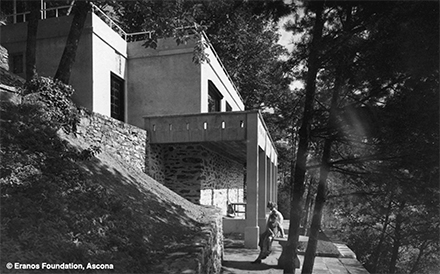Submitted by ARASAllison on
 More than eighty-five years have passed since the founding of the Eranos Conferences (Eranos Tagungen) in 1933. This pioneering endeavor of interdisciplinary gatherings, which has been properly recognized as “one of the most creative cultural experiences in the modern Western world” and “one of the richest centers of intellectual and spiritual interchange known to our century,” was promoted in Ascona (Switzerland) by Olga Fröbe-Kapteyn (1881–1962).
More than eighty-five years have passed since the founding of the Eranos Conferences (Eranos Tagungen) in 1933. This pioneering endeavor of interdisciplinary gatherings, which has been properly recognized as “one of the most creative cultural experiences in the modern Western world” and “one of the richest centers of intellectual and spiritual interchange known to our century,” was promoted in Ascona (Switzerland) by Olga Fröbe-Kapteyn (1881–1962).
In the case of Carl Gustav Jung (1875–1961), who was among the main inspirers of Eranos since the early ‘30s, the publication of The Red Book helped to realize all the more the strict connection between his personal and his intellectual paths. Up to now, several of Olga Fröbe-Kapteyn’s allusions have sounded much more hermetic. For example, she stated, “The deepest things in human life … can only be expressed in images.” Or: “I beg your pardon if I am speaking through images! This is the way my mind works.” These are words that become much clearer now in the light of her artworks, which can be conceptually and temporally situated in two periods: a first series of “Meditation Plates,” created between 1926 and 1934, and in particular during the period of her collaboration with esotericist and theosophist Alice Ann Bailey (1880–1949); and a second series of “Visions”: an outstanding collection of over three-hundred paintings that were realized – with the Jungian technique of the active imagination – between 1934 and 1938. These were the crucial years of the beginning of Olga Fröbe-Kapteyn’s cultural enterprise, her longstanding relationship with Jung, and her research into iconographic material entrusted to her by Jung, which led to the creation of the Eranos Archive for Research in Symbolism.
Olga Fröbe-Kapteyn was born in London of Dutch parents, from a culturally rich background, on October 19, 1881. Her father, Albertus Philippus Kapteyn (or Kapteijn, 1848–1927), was director and later vice-president of the Westinghouse Brake & Signal Company in London. Her mother, Geertruida (Truus) Agneta Kapteyn-Muysken (1855–1920), was involved in women’s emancipation and social renewal movements. Olga Fröbe-Kapteyn was the eldest of three children. Her interest in art can be traced back to the fascination she experienced in her childhood, when her father, a passionate photographer, in their home in London, developed photographic films in the darkroom under the curious eyes of his little daughter.
In 1900, Olga Fröbe-Kapteyn moved to Zurich with her father. There she attended the “School of Applied Arts,” excelling in tailoring, embroidery, and jewelry. From 1906 to 1909, she continued his education in art history at the University of Zurich. In 1909, she married the orchestra conductor, Iwan Fröbe (1880–1915), with whom she lived in Munich, Berlin, Gersau am Vierwaldstättersee, and then, from December 1914, in Zurich again. In Berlin, she had attended a sewing club, “The Needle,” founded by art historian André Jolles (1874–1946); her silk blouse with colored embroidery was exhibited in 1916 as part of a textile exhibition at the Museum of Applied Arts in Zurich.
Widowed in September 1915, Olga Fröbe-Kapteyn ran her own cultural club in Zurich. In 1919–1920, she moved to the South of Switzerland, to take advantage of some natural treatments at the famous Sanatorium Monte Verità in Ascona. In those years, in Europe, many movements of “reform of life” inspired by the East were born, among which Monte Verità (“Mountain of Truth”) was one of the most striking and fortunate examples. It is in this context that the psychoanalyst, anarchist, and revolutionary Otto Gross (1877–1920) between 1905 and 1911, had planned to create the prototype of an ideal matriarchal society. In love with the beauty of the place, in 1920, Olga Fröbe-Kapteyn settled down in the charming Casa Gabriella in Ascona-Moscia, on the shores of Lake Maggiore. It was there that during a long period of solitary “concentration discipline” (Konzentrationsdiszipline), which lasted seven years, she familiarized herself with oriental philosophies, esotericism, and meditation.
Read Olga Fröbe-Kapteyn (1881–1962): A Woman’s Individuation Process through Images at the Origins of the Eranos Conferences in its entirety here.